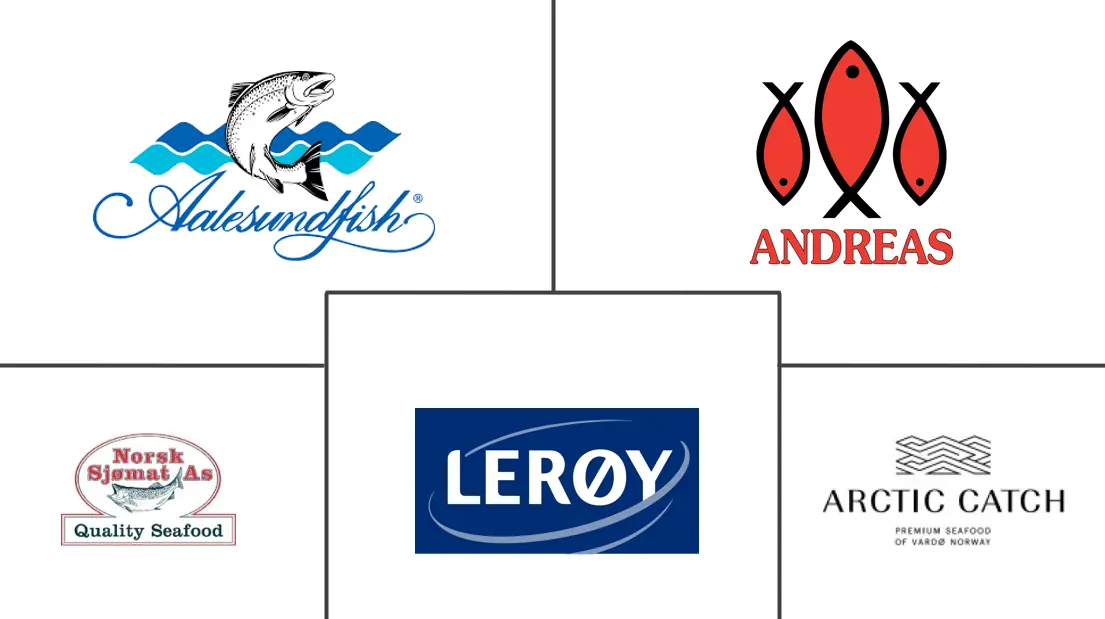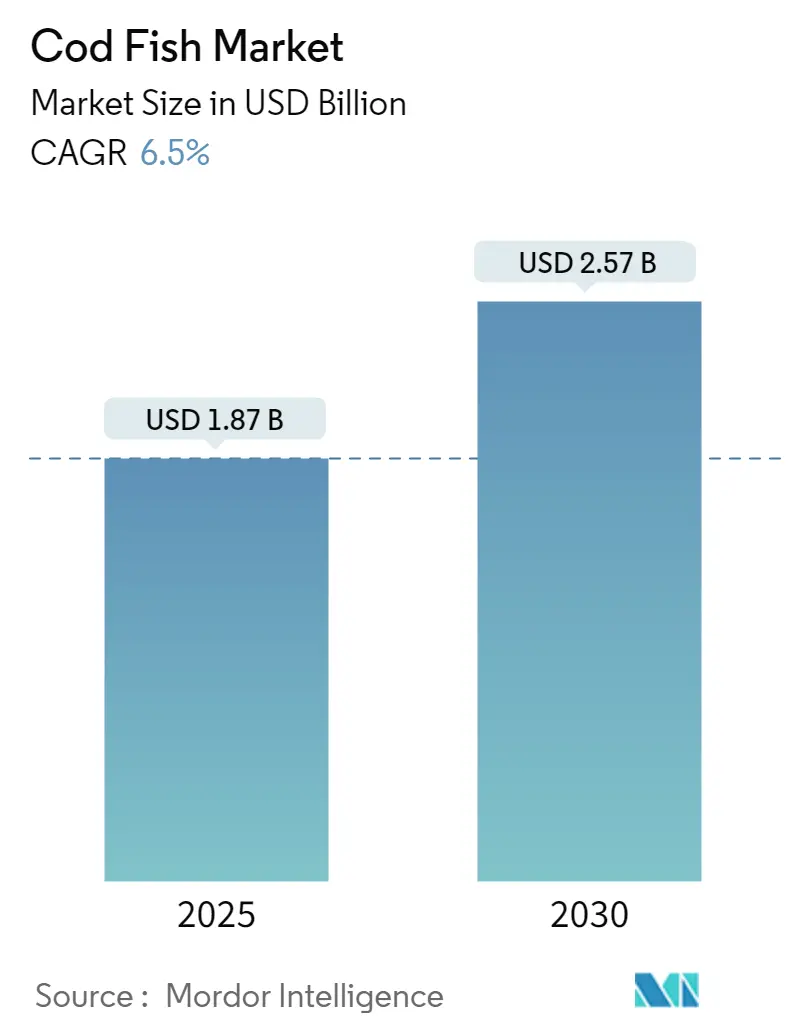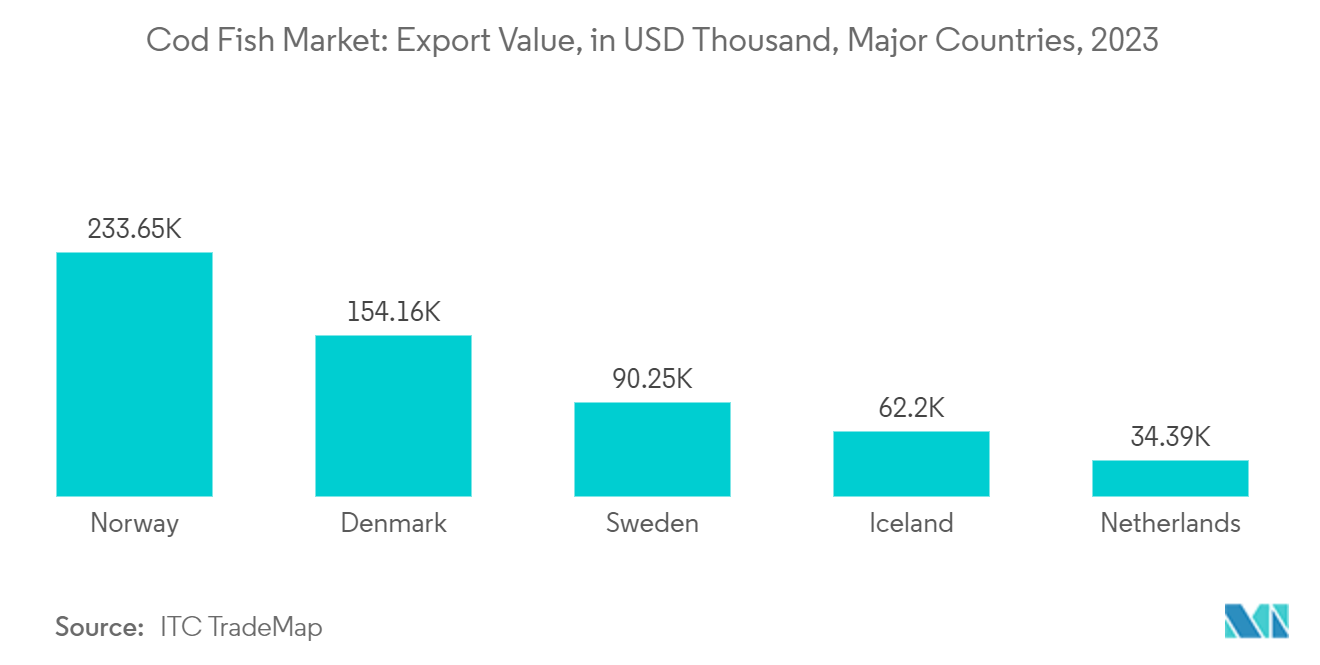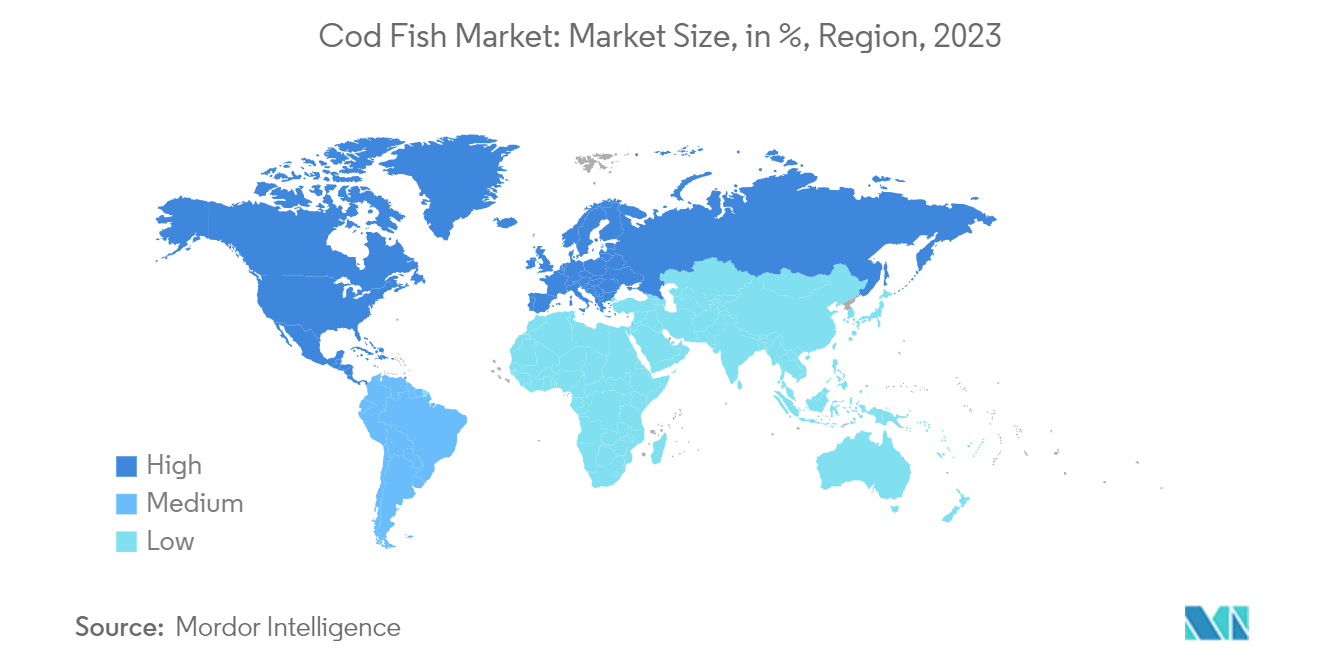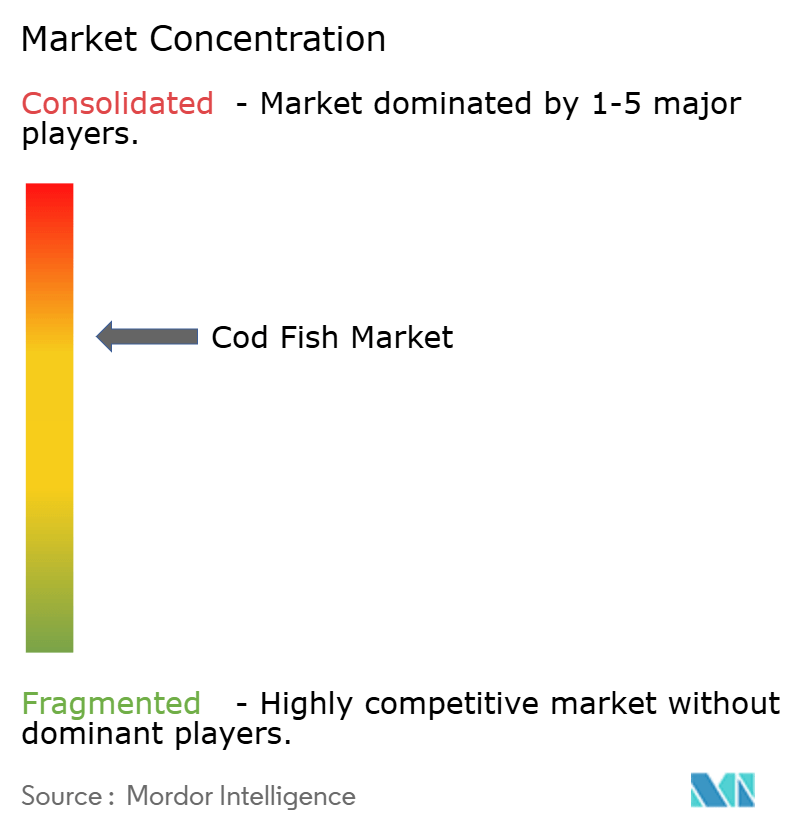Cod Fish Market Analysis
The Cod Fish Market size is estimated at USD 1.87 billion in 2025, and is expected to reach USD 2.57 billion by 2030, at a CAGR of 6.5% during the forecast period (2025-2030).
As global fish demand surges, there's a pronounced pivot towards export-driven aquaculture and the adoption of 'Scientific Aquaculture Management Practices' (SAMP). In 2022, global aquaculture production hit 130.9 million metric tons, valued at USD 312.8 billion, accounting for 59% of the worldwide fisheries and aquaculture output, as highlighted in The State of World Fisheries and Aquaculture 2024 report.
Codfish emerges as a leading global seafood trade, playing a crucial role as an animal protein source. The seafood trade boasts a value that's 3.6 times that of beef, 5 times that of pork, and an astonishing 8 times larger than the global poultry trade. Data from ITC Trademap reveals that in 2023, Norway, Denmark, Sweden, and Iceland dominated the export scene, collectively accounting for 37.3%, followed by 24.6%, 14.4%, and 9.9% respectively.
The 2024 State of World Fisheries and Aquaculture report highlighted that in 2022, the sector generated 92.3 million tonnes valued at approximately USD 159 billion. This comprised 91.0 million metric tons of aquatic animals – with 79.7 million metric tons sourced from marine areas and 11.3 million metric tons from inland waters – alongside 1.3 million metric tons of algae. Marine capture fisheries, holding a 43% share, continue to be the dominant source of global aquatic animal production. With escalating R&D investments and major industry players globally embracing fish farming, the market is set for growth in the coming years. The European Union stands out as Norway’s primary market, representing 60% of its export value. For the past eight years, Vietnam has secured its position as the third-largest exporter of aquatic products. In 2022, China led as the top producer, accounting for 36 percent of the total aquatic animal production, trailed by India (8%), Indonesia (7%), Vietnam (5%), and Peru (3%). Consequently, with rising international standards and elevated global prices for aquaculture products, the market is expected to lean further towards sustainable aquaculture practices.
Cod Fish Market Trends
Increase in the Fish Demand
Globally, fisheries and aquaculture are increasingly recognized as vital sources of protein, foreign exchange, and livelihoods. The FAO's 2022 report on the State of World Fisheries and Aquaculture highlighted a historic milestone: total production reached 223.2 million metric tons in 2022. This included 185.4 million metric tons of aquatic animals and 37.8 million metric tons (wet weight) of algae, marking a 4.4% increase from 2020. Marine areas contributed 62% of the harvested aquatic animals (with 69% sourced from fisheries and 31% from aquaculture), while inland waters accounted for the remaining 38% (84% from aquaculture and 16% from capture fisheries).
As per the World Bank, by 2032, aquatic animal production is set to increase by 10%, driven by aquaculture expansion and a rebound in capture fisheries. The total output is projected to reach 205 million metric tons, with 111 million metric tons from aquaculture and 94 million metric tons from fisheries. Notably, up to 90% of this production will be designated for human consumption, averaging about 21.3 kg per person. While per capita consumption is expected to rise globally, Africa is projected to see a decline. This is particularly alarming for sub-Saharan Africa, where many rely on aquatic foods for nutrition. Demand for fish in China continues to outstrip domestic supply, as highlighted by Agriculture and Agri-food Canada. Meanwhile, North America and Europe, despite having smaller aquaculture industries, heavily rely on Asian producers to satisfy their high demand for fish and seafood.
Heightened nutritional awareness among consumers and the global surge of aquaculture have significantly boosted aquafeed sales. In countries like Norway, Sweden, and Denmark, codfish production has surged in tandem with the rapid growth of the aquaculture sector. The volume of Atlantic cod caught by the Norwegian fleet saw fluctuations between 2021 and 2022. In 2022, Norway's Atlantic cod catch reached approximately 348 thousand metric tons, up from 331.5 thousand metric tons in 2020. This underscores the tightening supply-demand dynamics of codfish and other aquaculture species in international markets.
Europe Dominates the Market
According to the State of World Fisheries and Aquaculture 2022, global inland aquaculture showcases a rich tapestry of cultural methods and facilities. Operations and practices differ widely, influenced by factors such as input intensity, technological and management sophistication, and integration with other farm activities. Worldwide, the predominant method remains the cultivation of finfish and other species in constructed earthen ponds.
Historically, codfish imports predominantly hailed from Canadian regions. However, in 2020, the landscape shifted, with Norway accounting for 49% of Portuguese cod imports, trailed by Denmark at 27% and Iceland at 19%. As per the European Market Observatory for Fisheries and Aquaculture Products, 2021, Norway's dominance in the global codfish trade is evident, capturing roughly one-third of the annual global catch of Atlantic cod, translating to about 326,989 tons in 2020. In Portugal, codfish holds a cherished place in culinary traditions and cultural practices.
In 2024, the Norwegian Seafood Council underscored the growing importance of white fish farming, even as salmon, cod, and trout continue to dominate headlines in Norwegian aquaculture. July 2024 saw Norway's fresh cod exports touch 2,384 metric tons, valued at NOK 137 million (USD 13.39 million). Despite a 19% dip in overseas sales of trawler-caught fresh cod the previous month, farmed cod exports witnessed a remarkable upswing. July 2024 recorded a 200% surge in farmed cod exports, reaching 955 metric tons, with expectations of continued growth. The value of farmed cod exports jumped by 185%, hitting NOK 58 million (USD 5.49 million). While this pales in comparison to salmon figures, it highlights the rising stature of white fish aquaculture. The allure of farmed cod stems from its steady supply, unlike its wild-caught counterpart, which is susceptible to weather-related disruptions, especially in winter. Consequently, scientific aquaculture management has broadened the industry's perspective, emphasizing the demand side. By swiftly adapting to these trends, the potential for new business ventures and value creation across the global value chain is evident.
Cod Fish Industry Overview
The Cod fish market is consolidated, with few players holding a major market share. Aalesundfisk AS, Andreas Bjorge Seafood AS, Norsk Sjomat Stranda AS, Arctic Catch AS, and Leroy Seafood Group ASA are some major players operating across the globe. Leading companies in the market primarily adopt strategies such as new product launches, partnerships, and acquisitions. In addition to these, expansions, and investments in R&D, along with the development of novel product portfolios, are expected to play pivotal roles in the coming years.
Cod Fish Market Leaders
-
Aalesundfisk AS
-
Andreas Bjorge Seafood AS
-
Norsk Sjomat Stranda AS
-
Arctic Catch AS
-
Leroy Seafood Group ASA
- *Disclaimer: Major Players sorted in no particular order
Cod Fish Market News
- June 2024: The Government of Canada has lifted the moratorium on Northern cod off the north and east coasts of Newfoundland and Labrador. As a result, the commercial Northern cod fishery is back in NAFO Divisions 2J3KL, with a Canadian Total Allowable Catch (TAC) set at 18,000 metric tons for the 2024 season.
- October 2023: Moreforsking, a research institute, has collaborated with Ode on the LuxCod project to study the impact of cod in aquaculture settings. The main goal is to delay sexual maturation in farmed cod, which in turn boosts fish welfare, quality, and economic returns.
Cod Fish Industry Segmentation
Cod fish, a demersal fish from the genus Gadus and part of the Gadidae family, is widely used as a food source across various global regions, known for its mild flavor, cod boasts a dense, flaky, white flesh. The cod fish market is segmented by species type into atlantic cod fish, pacific cod fish, greenland cod fish, and other species types, by source type into farmed, and wild captured, by product type into fresh, canned, frozen, and other product types, by distribution channel into specialized fish shops, supermarkets/hypermarkets, online stores, and other distribution channels, and geography into North America, Europe, Asia Pacific, South America, and Africa. The report offers the market size and forecasts for value in (USD) for all the above segments.
| Species Type | Atlantic Cod Fish | ||
| Pacific Cod Fish | |||
| Greenland Cod Fish | |||
| Other Species Types | |||
| Source Type | Farmed | ||
| Wild Captured | |||
| Product Type | Fresh | ||
| Canned | |||
| Frozen | |||
| Other Product Types | |||
| Distribution Channel | Specialized Fish Shops | ||
| Supermarkets/Hypermarkets | |||
| Online Stores | |||
| Other Distribution Channels | |||
| Geography | North America | United States | |
| Canada | |||
| Mexico | |||
| Rest of North America | |||
| Europe | Spain | ||
| United Kingdom | |||
| France | |||
| Germany | |||
| Russia | |||
| Norway | |||
| Italy | |||
| Rest of Europe | |||
| Asia Pacific | China | ||
| India | |||
| Japan | |||
| Australia | |||
| Rest of Asia Pacific | |||
| South America | Brazil | ||
| Argentina | |||
| Rest of South America | |||
| Africa | South Africa | ||
| Rest of Africa | |||
Cod Fish Market Research FAQs
How big is the Cod Fish Market?
The Cod Fish Market size is expected to reach USD 1.87 billion in 2025 and grow at a CAGR of 6.5% to reach USD 2.57 billion by 2030.
What is the current Cod Fish Market size?
In 2025, the Cod Fish Market size is expected to reach USD 1.87 billion.
Who are the key players in Cod Fish Market?
Aalesundfisk AS, Andreas Bjorge Seafood AS, Norsk Sjomat Stranda AS, Arctic Catch AS and Leroy Seafood Group ASA are the major companies operating in the Cod Fish Market.
Which is the fastest growing region in Cod Fish Market?
Asia Pacific is estimated to grow at the highest CAGR over the forecast period (2025-2030).
Which region has the biggest share in Cod Fish Market?
In 2025, the Europe accounts for the largest market share in Cod Fish Market.
What years does this Cod Fish Market cover, and what was the market size in 2024?
In 2024, the Cod Fish Market size was estimated at USD 1.75 billion. The report covers the Cod Fish Market historical market size for years: 2019, 2020, 2021, 2022, 2023 and 2024. The report also forecasts the Cod Fish Market size for years: 2025, 2026, 2027, 2028, 2029 and 2030.
Cod Fish Industry Report
Statistics for the 2025 Cod Fish market share, size and revenue growth rate, created by Mordor Intelligence™ Industry Reports. Cod Fish analysis includes a market forecast outlook for 2025 to 2030 and historical overview. Get a sample of this industry analysis as a free report PDF download.

